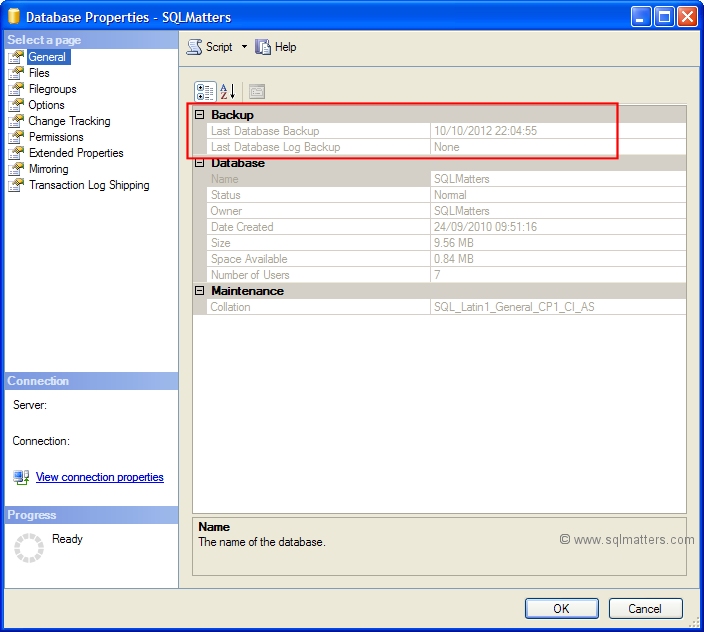It can be useful to periodically check when each database on a server was last backed up. The easiest way to do this on a single database is to right
click on the database in SQL Server Management Studio (SSMS) and looking at the top of the Database Properties page (see the screenshot
below).
However when there are several databases to check this can be quite labourious. SSMS actually uses the system table
backupset to populate
this part of the Properties page (you can verify this by running SQL Profiler just before opening the page).

I use a SQL script that uses
this table along with
backupmediafamily system table (to identify the file name of the backup) to query the latest backup of each type. The
script query returns the most recent backup of each type, whether it's a full, transaction log, differential, filegroup or partial backup. Here is the script :
;WITH CTE_Backup AS
(
SELECT database_name,backup_start_date,type,physical_device_name
,Row_Number() OVER(PARTITION BY
database_name,BS.type
ORDER BY backup_start_date DESC) AS RowNum
FROM msdb..backupset
BS
JOIN msdb.dbo.backupmediafamily BMF
ON BS.media_set_id=BMF.media_set_id
)
SELECT D.name
,ISNULL(CONVERT(VARCHAR,backup_start_date),'No backups') AS last_backup_time
,D.recovery_model_desc
,state_desc,
CASE
WHEN type ='D' THEN 'Full database'
WHEN
type ='I' THEN 'Differential database'
WHEN
type ='L' THEN 'Log'
WHEN
type ='F' THEN 'File or filegroup'
WHEN
type ='G' THEN 'Differential file'
WHEN
type ='P' THEN 'Partial'
WHEN
type ='Q' THEN 'Differential partial'
ELSE
'Unknown' END AS backup_type
,physical_device_name
FROM sys.databases D
LEFT JOIN CTE_Backup CTE
ON D.name
= CTE.database_name
AND RowNum =
1
ORDER BY D.name,type
As an aside the 'Last Database Backup' shown in SSMS does not seem to include filegroup or partial backups, only full,
differential or log backups. I'm not sure why this should be.
Identifying Databases Which Haven’t Been Backed Up Recently
The above query can return a lot of data if your server has many databases, so I've modified it to produce a list
of databases that have had no backups in the last 7 days (you might want to change this to a shorter period especially
for production databases) :
;WITH CTE_Backup AS
(
SELECT database_name,backup_start_date,type,is_readonly,physical_device_name
,Row_Number() OVER(PARTITION BY
database_name
ORDER BY
backup_start_date DESC)
AS RowNum
FROM msdb..backupset
BS
JOIN msdb.dbo.backupmediafamily BMF
ON BS.media_set_id=BMF.media_set_id
)
SELECT D.name
,ISNULL(CONVERT(VARCHAR,backup_start_date),'No backups') AS last_backup_time
,D.recovery_model_desc
,state_desc
,physical_device_name
FROM sys.databases D
LEFT JOIN CTE_Backup CTE
ON D.name
= CTE.database_name
AND RowNum =
1
WHERE ( backup_start_date IS NULL OR backup_start_date <
DATEADD(dd,-7,GetDate()) )
ORDER BY D.name,type
This will produce a list of databases for investigation, though of course there may be a good reason for a database not
being backed up, for instance it's not possible to backup database snapshots. Also if the secondary database of a log
shipping configuration there's not always a need to back it up.
Missing Transaction Log Backups
Finally I've modified the above query so that it reports all databases that have the full or bulk-logged recovery model and
where there hasn't been a transaction log backup in the last day :
;WITH CTE_Backup AS
(
SELECT database_name,backup_start_date,type,is_readonly,physical_device_name
,Row_Number() OVER(PARTITION BY
database_name,BS.type
ORDER BY backup_start_date DESC) AS RowNum
FROM msdb..backupset
BS
JOIN msdb.dbo.backupmediafamily BMF
ON BS.media_set_id=BMF.media_set_id
WHERE type='L'
)
SELECT D.name
,ISNULL(CONVERT(VARCHAR,backup_start_date),'No log backups') AS last_backup_time
,D.recovery_model_desc
,state_desc
,physical_device_name
FROM sys.databases D
LEFT JOIN CTE_Backup CTE
ON D.name
= CTE.database_name
AND RowNum =
1
WHERE ( backup_start_date IS NULL OR backup_start_date <
DATEADD(dd,-1,GetDate()) )
AND recovery_model_desc != 'SIMPLE'
ORDER BY D.name,type
I hope the above queries are of use in identifying databases where there is no recent backup in place. You really
don't want to be in a position where this is only discovered when the backup is actually needed, i.e. after a
disk failure or data corruption. Of course you should also be checking that your backups are valid, ideally by
periodically restoring from a backup, or at the very least by checking the backups using the
VERIFYONLY option
(though there is really no substitute for doing an actual restore).